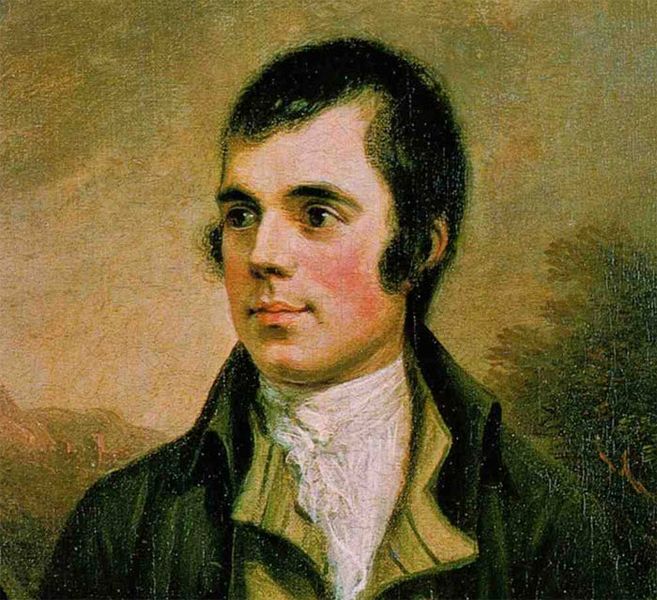 Burns Night is a celebration dedicated to the life and works of the great Scottish poet Robert (Rabbie) Burns. On 25th January, many people will be throwing a Burns Night supper, featuring all the traditional elements. The classic celebration includes a piper to welcome the guests, speeches, prayers to bring in the food, a special address and toast to the haggis, lively entertainment, a ‘toast to the lassies’ and many other fun elements.
Burns Night is a celebration dedicated to the life and works of the great Scottish poet Robert (Rabbie) Burns. On 25th January, many people will be throwing a Burns Night supper, featuring all the traditional elements. The classic celebration includes a piper to welcome the guests, speeches, prayers to bring in the food, a special address and toast to the haggis, lively entertainment, a ‘toast to the lassies’ and many other fun elements.
How will you be celebrating Burns Night in the EFL class? Read on to discover more about this fascinating Scottish tradition and how you might use it to create a fun, Scottish-themed EFL lesson.
History of Burns Night
Each year on the anniversary of Robert Burns’ death, people celebrate the life and works of Scotland’s great poet. The event has been held every year since 1801, five years after Burns’ death, when his friends decided to celebrate his memory by reading his poetry and holding a feast in his honour.
Burns Night is all about music, singing, poetry, fun speeches and of course, eating and drinking. The night is light-hearted and often quite boisterous, while at the centre of the entertainment are the songs and poems of Scotland’s famous bard, Rabbie Burns.
A Burns Night supper can be a large, formal event with hundreds of guests or a small, casual event with just a few people. You can incorporate as many or as few elements of the traditional supper as you like – but Rabbie Burns should always play a starring role!
Why not create your own version of a Burns Night supper in the EFL classroom? This special lesson would include various aspects of a traditional supper that get your students using their reading, writing, listening and speaking skills to create, perform and understand speeches, prayers, poems and songs.
Here is a breakdown of a traditional Burns Night supper:
Piping in the Guests
Burns Night begins with the arrival of the guests, accompanied by a Scottish bagpiper. As the guests arrive at the Burns Night supper, the piper should play a traditional Scottish tune. The guests are then officially welcomed by a speech from the host before thoughts turn to the meal itself and the Selkirk Grace.
The Selkirk Grace
As the Burns Night meal is brought in, a special prayer is read out called the Selkirk Grace. Burns is said to have given a version of this prayer at a dinner held by the Earl of Selkirk. The prayer thanks the Lord for the Burns Night food:
‘Some hae meat and canna eat,
And some wad eat that want it,
But we hae meat and we can eat,
And sae the Lord be thankit’.
Translated into English this would read something like:
‘Some have meat and can’t eat it,
And some would eat that want it,
But we have meat and we can eat it,
And say the Lord be thankful’
Address to the Haggis
At a Burns Night supper, the traditional food is that Scottish staple, the haggis. Haggis is a special Scottish food traditionally made with lamb offal mixed with herbs and onion and encased inside a sheep’s stomach, although modern haggis often uses an alternative for the casing.
The Burns Night guests stand and clap while the haggis is brought in to a rousing tune by the bagpiper. While the haggis is being welcomed, glasses are filled with whiskey to prepare for the toast. If you don’t have a piper, the guests can clap to welcome the haggis to the table.
A reader reads the address To a Haggis, which is a poem of eight verses that announces to the world the wonders of the haggis! Here is the first and last verse from the poem, written in 1786 by Rabbie Burns:
To a Haggis
Fair fa’ your honest, sonsie face,
Great chieftain o’ the pudding-race!
Aboon them a’ ye tak your place,
Painch, tripe, or thairm:
Weel are ye wordy o’a grace,
As lang’s my arm.
Ye Pow’rs, wha mak mankind your care,
And dish them out their bill o fare,
Auld Scotland wants nae skinking ware,
That jaups in luggies:
But, if ye wish her gratefu prayer,
Gie her a Haggis!
On this final phrase ‘Gie her a haggis!’ everyone cheers and the haggis is cut open to be served.
Before everyone can enjoy the flavours of the haggis, they must drink a toast to the haggis. The speaker raises a glass followed by the guests and everyone cries “The haggis!”

The Burns Night Meal
The Burns Night supper consists of a traditional cock-a-leekie soup (chicken and leek soup) as the starter, followed by a main course of haggis, neeps (swede) and tatties (potatoes).
For dessert, clootie dumpling (pudding prepared in a cloth) or Typsy Laird (sherry trifle) is served. After dessert a cheeseboard is brought in with bannocks (oatcakes) and coffee.
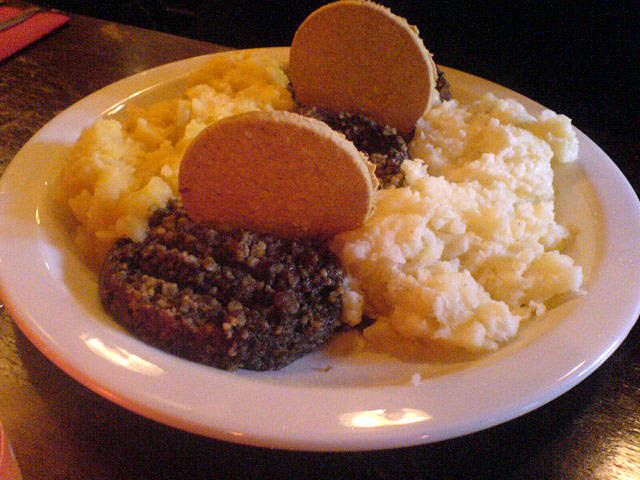
The Burns Night meal is sometimes altered according to taste, so the haggis could be the starter with another meat dish as the main course.
Vegetarian haggis does exist, so even if you don’t eat meat this is no reason not to join in the Burns Night supper! In fact, many people eat haggis with an alternative casing with lentils and beans instead of meat, so those with delicate stomachs or an aversion to offal can still partake in the famous Scottish dish.
Throughout the meal, the guests drink wine or beer and afterwards enjoy Scottish malt whiskey.
Burns Night Entertainment
After the meal it is time for the entertainment, which consists of music and poetry by Rabbie Burns. One popular song for the musicians to play at a Burns Night supper is My Luve is Like a Red Red Rose, which is a wonderful poem set to music:
My Luve is Like a Red Red Rose
O my Luve’s like a red, red rose,
That’s newly sprung in June:
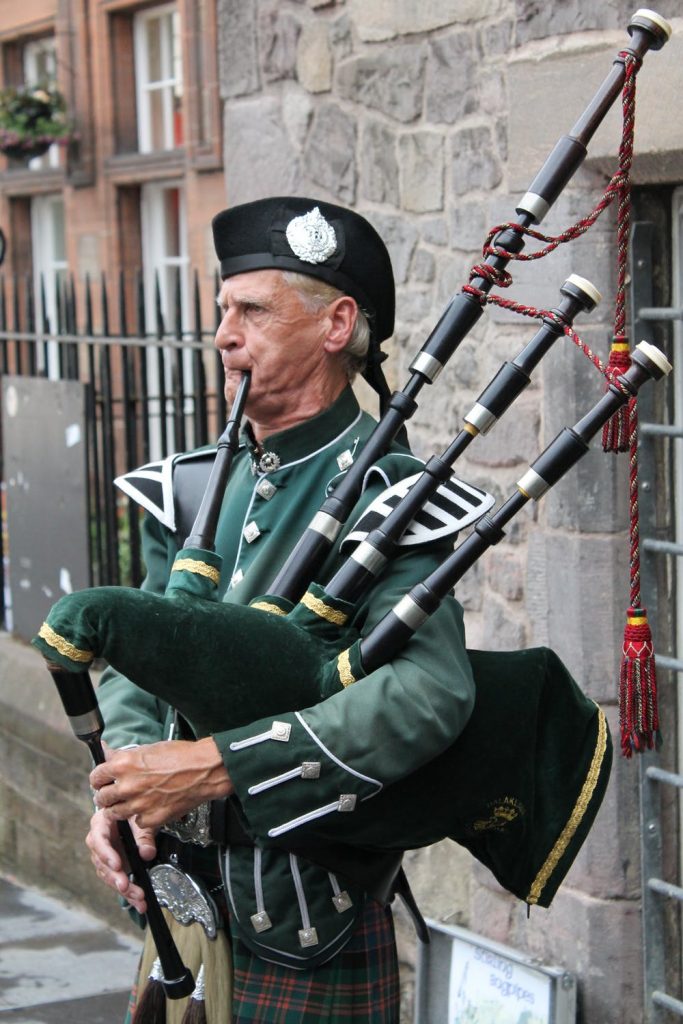
O my Luve’s like the melodie,
That’s sweetly play’d in tune.
As fair art thou, my bonie lass,
So deep in luve am I;
And I will luve thee still, my dear,
Till a’ the seas gang dry.
Till a’ the seas gang dry , my dear,
And the rocks melt wi’ the sun;
And I will luve thee still, my dear,
While the sands o’ life shall run.
And fare-thee-weel, my only Luve !
And fare-thee-weel, a while!
And I will come again, my Luve,
Tho’ ’twere ten thousand mile!
Burns Night Poetry
There are many Burns poems that grace a Burns Night supper. One particular favourite which can often be heard on Burns Nights is Tam O Shanter. Here is the first stanza of this epic poem:
Tam O’Shanter
When chapman billies leave the street, And drouthy neibors, neibors, meet;
As market days are wearing late, And folk begin to tak the gate,
While we sit bousing at the nappy, An’ getting fou and unco happy,
We think na on the lang Scots miles, The mosses, waters, slaps and stiles,
That lie between us and our hame, Where sits our sulky, sullen dame,
Gathering her brows like gathering storm, Nursing her wrath to keep it warm.
This truth fand honest Tam o’ Shanter, As he frae Ayr ae night did canter:
(Auld Ayr, wham ne’er a town surpasses, For honest men and bonie lasses).
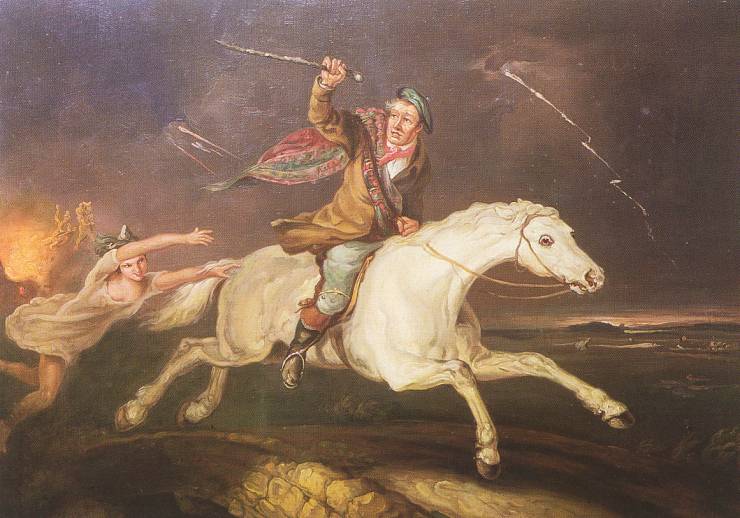
The Immortal Memory
After the poems and songs, we have a toast to the ‘Immortal Memory of Robert Burns’. This is the most formal part of the evening. During the toast the speaker will talk about the life and poetry of Scotland’s great bard with reference to his patriotism.
After the Immortal Memory toast comes more entertainment, which consists of lively music, singing and poetry.
The Toast to the Lassies
The Toast to the Lassies is a time for humour. The toast is a tongue-in-cheek speech about the greatness of women, incorporating a verse from Rabbie Burns’ poems and including good-natured banter. A male speaker will make this cheeky toast and it always ends with the phrase “To the lassies!”
The Lassies’ Reply
After the Toast to the Lassies, the women of the group have their chance to give a spirited reply! This is sometimes called the Toast to the Laddies. This speech and toast is given by a female speaker who will make a witty retort to the male speaker.
Auld Lang Syne
At the end of the Burns Night supper, everyone joins together to sing a hearty rendition of Auld Lang Syne. This song is traditionally sung across the UK on New Year’s Eve just after the clock strikes midnight.
The best Burns Night suppers are lively affairs with plenty of guest participation. The night can include some other types of entertainment such as quizzes, games, stories and lots of humour.
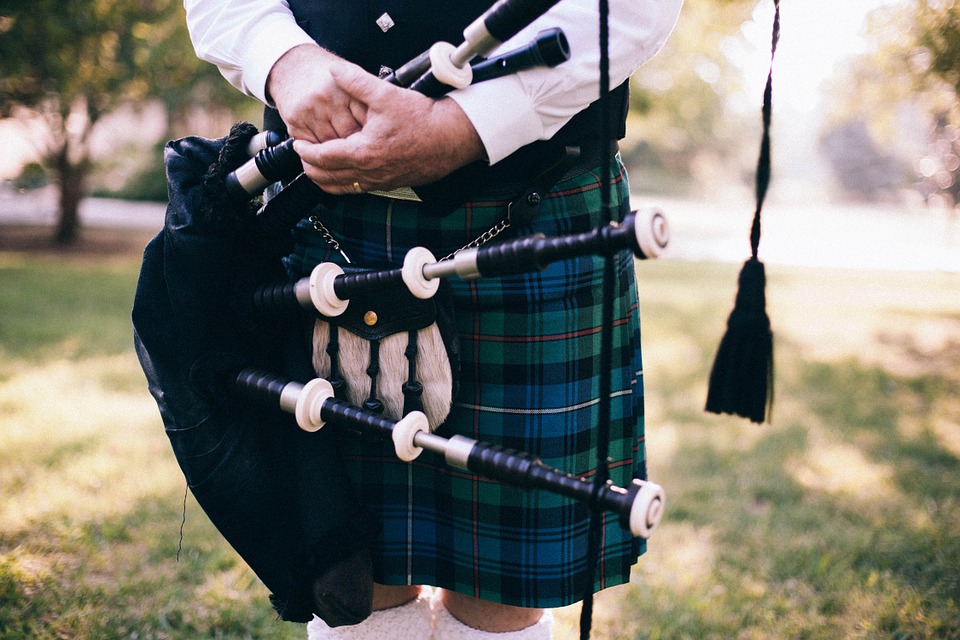
Burns Night EFL Lessons
Burns Night is a great opportunity to introduce your EFL class to new vocabulary and help them learn more about Scottish traditions, especially about the importance of Robert Burns. This is also a good time to discuss the Scottish accent and dialect.
Teachers can present all the parts of the Burns Night supper, and the class can discuss each aspect, from the food to the poetry. A fun activity is the Toast to the Lassies and Laddies, where the class can split up into groups and prepare their own toasts to each other. Don’t forget the toast to the haggis!
This is an ideal time for student to practise their writing and speaking skills as they prepare and give their speechs and toasts. Students can also make up their own poems and try to emulate Scottish words.
For a more personal look at this interesting cultural day, teachers could bring in a haggis to the class so students can taste for themselves a food that is quite rare on normal occasions, especially outside Scotland. This could lead onto a discussion about traditional food from their own countries.
What food would students put on their dream menu for a celebratory supper?
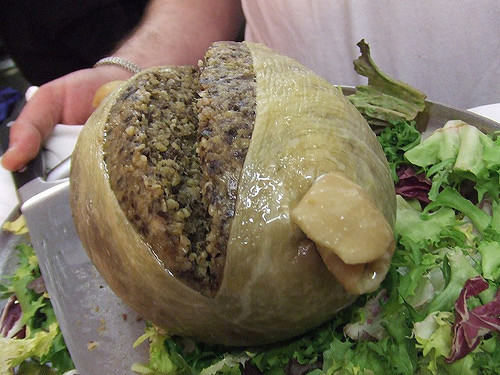
Burns Night EFL Lesson for Different Ability Levels
Depending on the ability level of the class, this can be a challenging lesson with many new ideas or fun, light-hearted lesson ideal for exploring Scottish culture.
You could use the order of the Burns Night supper to run your own version of a Burns Night celebration in class. Different groups of students could be placed in charge of the various aspects of the evening.
Share your thoughts on Burns Night
Do you have any more ideas for incorporating Burns Night into the EFL classroom?
Have you eaten haggis? What would you include in your toast to this classic Scottish dish?
Imagine you are preparing a ‘Toast to the Lassies’ or a ‘Toast to the Laddies’ – what would you include in your speech?
Do you have a favourite poem by Rabbie Burns?
Share your Burns Night experiences in the comments and let us know your plans for this year!
Attributions
- The classic Scottish dishes: Haggis, neeps & tatties at Clever Dicks on Edinburgh’s Royal Mile. Image by Edinburgh Blog [CC BY 2.0], via Wikimedia Commons
- Tam O’Shanter painting (1866) by John Joseph Barker (1824-1904),By John Joseph Barker (1824-1904) [Public domain], via Wikimedia Commons
- Haggis by Tess Watson via Flickr [CC BY 2.0]

We celebrated Burns Night for the first time this year – loved Rabbie’s poems especially ‘to a haggis’! We made our own toasts to the lassies and laddies but chickened out of proper haggis – we had a vegetarian haggis from Waitrose, which was like a nut roast – very nice.
Thanks for this info, really helpful for preparing our own Burns night supper. I teach English to foreign students and have used Rabbie’s poems as an insight into the Scottish language – a funny lesson!
Best wishes to you all and keep up the good work!
Hi Fiona
Thanks for your comment! Your nut roast sounds delicious. It is always fun to make up your toasts to the lassies and laddies on Burns Night – these can be full of great banter, depending on who is sitting around the table!
I agree, Burns Night is ideal for introducing Scottish words and touching on the Scottish accent. It can sometimes be a surprise to students that Scottish can sound so different from English! Did you see our blog post on the Scottish accent and on Scottish traditions? Your students might find these interesting too 🙂
All the best,
Catherine
this article is very useful, thank you for making a good article